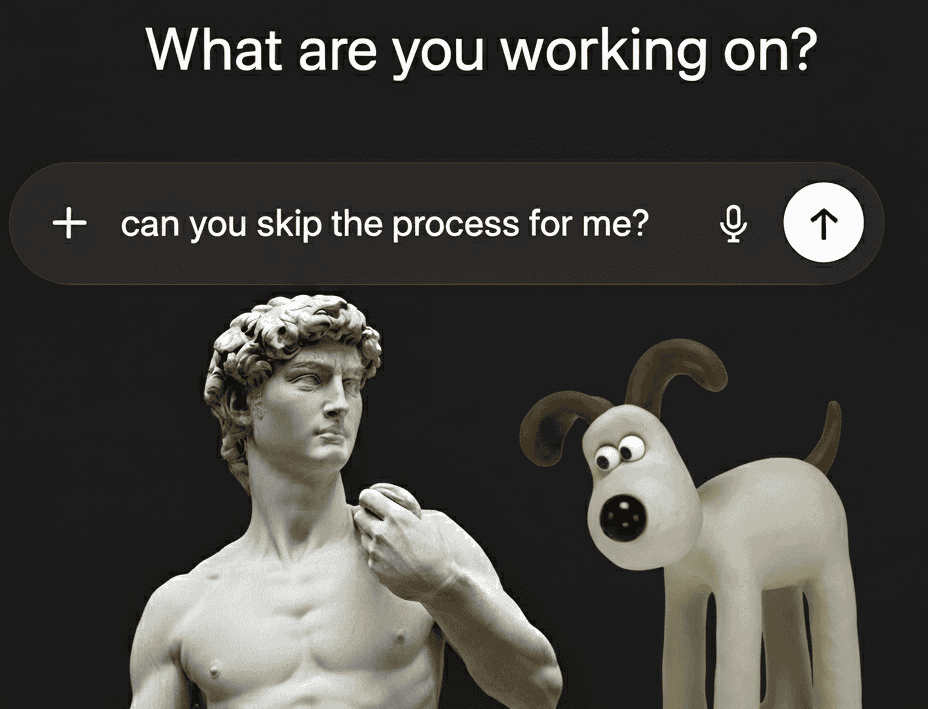A day is literally a blink, in claymation terms. The animators behind Wallace & Gromit will spend weeks on the slightest facial expression, tweezering every millimetre of eyelid movement, rigging and shifting Gromit’s plasticine peepers, which themselves are among hundreds carefully designed to reflect light, expression and nuance.
A second is a blink, in generative AI terms. No slow dance between ideation and execution, no Darwinian crawl, no carpal tunnel from folding Gromit’s eyelids, just a prompt and a near-instant output. With the bottleneck of creation being lifted, we’re invited to ask - what’s lost in the removal of process?
Time, skill, and resource aren’t just constraints to creativity, but regulators. They force ideas to pass through a gauntlet that either improves or discards them. Remove the space between idea and result, and the fl oodgates holding back the sea of imagination slop are lifted - all the fever-dreams that would never survive a sketchbook, rehearsal room, or red pen, come bursting through. I’m sure you’ve felt this fl ood. The creative process doesn’t just reality test ideas, it quality tests them, but it also shapes and expands them.
Cast your mind to 1400s Florence. For 25 years, an 18-foot-tall block of white marble stood degrading in a cathedral courtyard. For all its initial promise, sculptors wouldn’t go near it. Too narrow to shape freely, veined with streaks of weak stone, fracture-prone - one wrong chisel and the slabs in shards. Eventually, studying the stone, a sculptor saw it through.
The marble’s limited depth, awkward proportions, and the frustrated hackings of earlier attempts presented a signifi cant challenge. The sculptor shaped the statue around these constraints - aligning the weight-bearing leg with the strongest vein, inward-angled limbs, compact pose, and shaping the posture around the scars. The result? An output shaped by process and constraint - Michelangelo’s David, was complete. Oftentimes, the parameters of creativity shape the result for the better.
It’s not enough to leap from idea to outcome; the space between these points is integral to the final product. Doing the work, building the prototype, playing the notes, mixing the paints, working to the budget - ideas become something else on their path to completion.
Take bubble wrap and Post-it notes - both began life with abandoned purposes - one as a wallpaper concept, the other as a bookmark. In their development and application, their promise expanded.
So, the creative process prunes, adapts, and evolves ideas beyond their original conception. With the collapse of that space, we remove the parameters to creativity, but we also lose the forces that, often enough, turn an idea into its best version.
Naturally, this isn’t the full picture. For all that’s lost when we skip the work, there are gains to consider.
Nobody’s deleting their translation app because it skips the “poetry” of manual translation, or uninstalling their coding copilot out of respect for the “programming journey.” Sometimes, the shortest route is the best one - freeing time, removing restrictions, levelling the playing field.
And that leveling is moving fast. AI titans like OpenAI’s Sam Altman foretold of an “every employee a CEO” AI utopia, and while this remains questionable, the democratisation of skill is expanding: every user a Rembrandt, every prompter a Beethoven. With this new competitive landscape, we’re unlikely to see excellence erased; we’re more likely to see it redefined.
The electric guitar didn’t kill music, photography didn’t destroy art - they brought new standards and expanded the meaning of mastery. No doubt AI will do the same.
The challenge for us is discernment. Sometimes the work needs the journey; sometimes speed serves the work. Knowing which is which will matter more and more, because some details only reveal themself in the blink.




